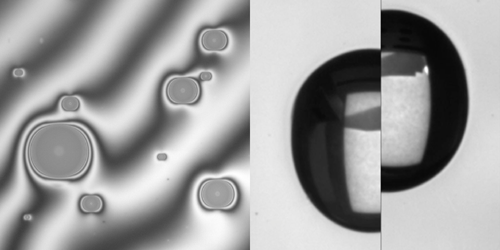Droplets Sliding Across a Stretched Surface
Biological and chemical assays are increasingly automated using microfluidic chips, which control the motions of tiny droplets with microscopic pillars, bumps, and other features. Now, Katrina Smith-Mannschott at the Swiss Federal Institute of Technology (ETH) in Zurich and colleagues demonstrate an alternative way to manipulate such droplets—by stretching the substrate they sit on [1]. The approach could lead to simpler techniques for fabricating microfluidic devices.
The researchers studied how glycerol droplets of 2 mm in diameter slide on a soft, millimeter-thick layer of silicone gel. When they stretched the gel layer by 23% of its original length, the droplets slid significantly faster in the direction parallel to the applied stretch than in the perpendicular direction. When the droplets stopped moving, they appeared elongated along the stretch direction, with smaller droplets exhibiting greater anisotropies.
According to existing theories of wetting, static droplets on homogeneous surfaces should contract uniformly, wetting a circular region of the substrate. To understand the different dynamics on a stretched surface, the researchers examined the droplets’ boundaries microscopically. They found that the wetting ridge—a usually uniform “puckering” of the substrate around the perimeter of each droplet—was asymmetric and that the degree of asymmetry depended on how much the substrate had been stretched. From this observation, they suggested that a droplet elongates because the variation in ridge shape around its perimeter creates an imbalance of intermolecular forces between the substrate and the droplet. These forces, which are responsible for a range of elastocapillary effects in other systems (see Synopsis: Hair Styling with Physics), also explain the strain-dependent increase in droplet speed. The researchers hope that additional experiments will reveal the limits on asymmetric wetting behavior that can be achieved with this technique.
–Sophia Chen
Sophia Chen is a freelance science writer based in Columbus, Ohio.
References
- K. Smith-Mannschott et al., “Droplets sit and slide anisotropically on soft, stretched substrates,” Phys. Rev. Lett. 126, 158004 (2021).




